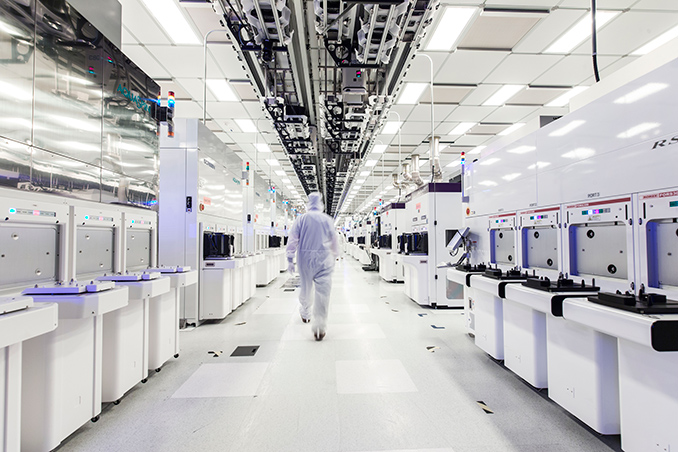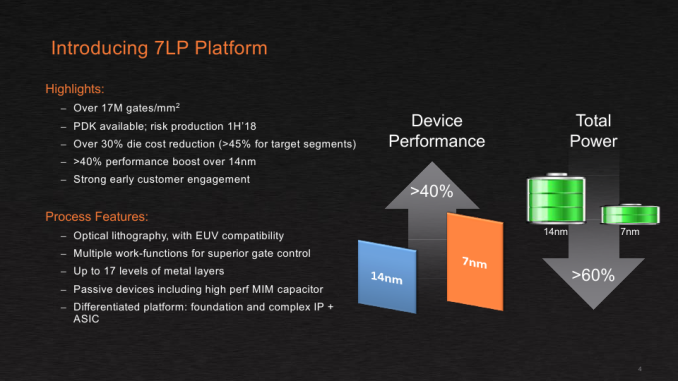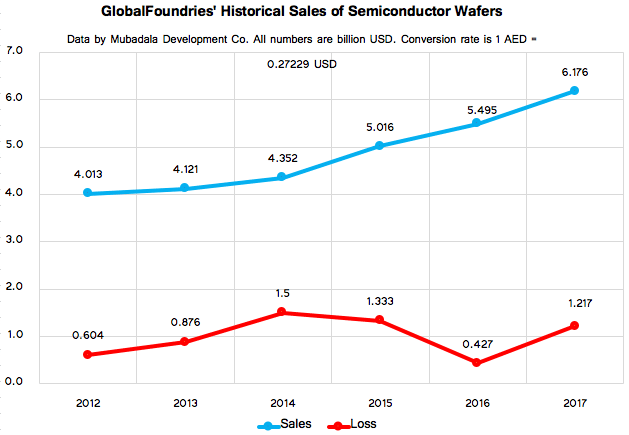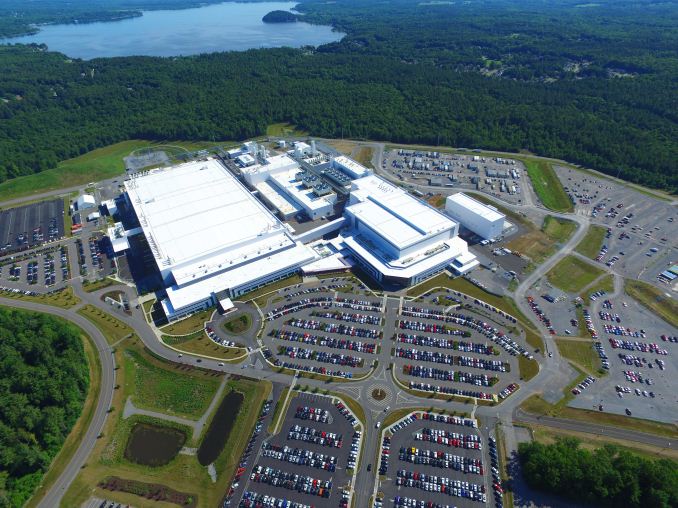GlobalFoundries Stops All 7nm Development: Opts To Focus on Specialized Processes
by Anton Shilov & Ian Cutress on August 27, 2018 4:01 PM EST- Posted in
- Semiconductors
- CPUs
- AMD
- GlobalFoundries
- 7nm
- 7LP

GlobalFoundries on Monday announced an important strategy shift. The contract maker of semiconductors decided to cease development of bleeding edge manufacturing technologies and stop all work on its 7LP (7 nm) fabrication processes, which will not be used for any client. Instead, the company will focus on specialized process technologies for clients in emerging high-growth markets. These technologies will initially be based on the company’s 14LPP/12LP platform and will include RF, embedded memory, and low power features. Because of the strategy shift, GF will cut 5% of its staff as well as renegotiate its WSA and IP-related deals with AMD and IBM. In a bid to understand more what is going on, we sat down with Gary Patton, CTO of GlobalFoundries.
7LP Canned Due to Strategy Shift
GlobalFoundries was on track to tape out its clients’ first chips made using its 7 nm process technology in the fourth quarter of this year, but “a few weeks ago” the company decided to take a drastic, strategic turn, says Gary Patton. The CTO stressed that the decision was made not based on technical issues that the company faced, but on a careful consideration of business opportunities the company had with its 7LP platform as well as financial concerns.
It is noteworthy that when GlobalFoundries first announced its 7LP platform in September 2016, it said that it would start risk production of processors using this technology in early 2018 (PR), which means that the first chips should have been taped out before that. When the company detailed the process in June 2018, it said that it expected to start “volume production ramping in the second half of 2018” (PR), which would be close to impossible if customers taped out their first chips only in Q4.
Generally, it looks like the company had to adjust its roadmap somewhere along the way, moving the start of high-volume manufacturing (HVM) further into 2019. Whether or not these adjustments had any implications on GlobalFoundries is up to debate. Keep in mind that AMD’s first 7 nm product was designed for TSMC’s CLN7FF from the beginning, so the company did not bet on GF’s 7LP in late 2018 anyway, and no rush with the manufacturing technology was needed for GF’s key customer.
Along with the cancellation of the 7LP, GlobalFoundries essentially canned all pathfinding and research operations for 5 nm and 3 nm nodes. The company will continue to work with the IBM Research Alliance (in Albany, NY) until the end of this year, but GlobalFoundries is not sure it makes sense to invest in R&D for ‘bleeding edge’ nodes given that it does not plan to use them any time soon. The manufacturer will continue to cooperate with IMEC, which works on a broader set of technologies that will be useful for GF’s upcoming specialized fabrication processes, but obviously it will refocus its priorities there as well (more on GF’s future process technologies later in this article).
So, the key takeaway here is that while the 7LP platform was a bit behind TSMC’s CLN7FF when it comes to HVM – and GlobalFoundries has never been first to market with leading edge bulk manufacturing technologies anyway – there were no issues with the fabrication process itself. Rather there were deeper economic reasons behind the decision.
Economic Reasons Behind the Move
As we noted in our article covering GlobalFoundries's new CEO hire earlier this year, former CEO Sanjay Jha was never able to make the company profitable. His key tasks were to increase GlobalFoundries’s sales, streamline the company in general, and ensure that it executes its roadmap.
To address the needs of the manufacturer’s traditional key client (AMD) and ensure that his company was competitive against other contract makers of semiconductors, he licensed Samsung Foundry's 14LPP fabrication technology. That strategy worked well. With Sunjay Jha at the helm, GlobalFoundries has managed to land a variety of new customers and increase its sales of semiconductor wafers from approximately $4.121 billion in 2013 to $6.176 billion in 2017. Besides, the foundry’s leading-edge Fab 8, which has been processing wafers using exclusively 14LPP process technology for well over 1.5 years now, is running at full capacity.
To ensure that GlobalFoundries remains competitive against Samsung Foundry and TSMC in the long run, Sunjay Jha obtained IP and development teams from IBM (along with two fabs and a lot of obligations), and poured in billions of dollars in development of the 7LP fabrication technology platform. The latter would include three generations of manufacturing processes and, possibly, a custom high-performance technology available exclusively to IBM. While everything appeared to proceed smoothly with the 1st Gen 7 nm process (DUV only), the 2nd Gen 7 nm process (with EUV used for non-critical layers, such as padding) still needed some additional development investments, and the 3rd Gen 7 nm (with intensive usage of EUV) required even more money for development and further could require installation of additional EUV equipment. Meanwhile, there were two things to consider.
First. If GlobalFoundries kicks off production using the 1st Gen 7 nm fabrication process, it would have needed to cure all of its teething troubles and offer its clients a roadmap forward. The latter would have included 2nd Gen and 3rd Gen 7 nm, but nothing stops there. Customers would have asked for 5 nm and then for 3 nm nodes. Meanwhile, you cannot tell your clients that you are packing up after a certain node and then hope that this node will be a success (the same is true for DUV-only 1st Gen 7 nm).
Second. Development of leading-edge process technologies is extremely expensive. Every new node requires billions of dollars in investments. Those costs are eventually amortized over each chip the company makes, so to keep increasing R&D costs from driving up chip prices, foundries need to produce more chips. To make more chips, they need to either run multiple fabs that use the same process technology (these are going to cost $10+ billion in the EUV era), or build giant fabs that process a gargantuan number of wafers (these are going to cost $20+ billion in the EUV era). Meanwhile, GlobalFoundries has only one leading-edge fab featuring capacity of 60,000 wafer starts per month. As a result, either GlobalFoundries has to pass these R&D costs on to the finite number of wafers it processes – and become uncompetitive against rivals in the process – or eat the costs with reduced profitability.
Meanwhile, having spent well over $20 billion on GlobalFoundries over the last 10 years, Mubadala, the owner of the company, is not inclined to lose more money or invest tens of billions in the hopes of becoming profitable one day. The investor wants GlobalFoundries to stop bleeding and start generating profits.
“The culture of [our investments], the ones I’ve been involved with, was about accumulating assets and then just maintaining it,” said Mubadala CEO Khaldoon Al Mubarak in an interview with Bloomberg earlier this year. “The shift that has happened over the last couple of years, that I’ve tried to push at Mubadala today, is a monetization strategy that makes sense, not with a view to cash out but with a view to reinvest.”
Gary Patton admits that GlobalFoundries never planned to be a leading producer of 7-nm chips in terms of volume. Furthermore, the company has been seeing increasing adoption of its 14LPP/12LP technologies by designers of various emerging devices, keeping Fab 8 busy and leaving fewer step-and-scan systems for 7LP products.
Without another big fab, it would be impossible to make any new leading-edge process technology competitive against Samsung and TSMC due to aforementioned scale reasons. Meanwhile, building a new fab (or even expanding the Fab 8 with another clean room module, which is something that GF considered several years ago) and creating another node or two would require another $10 – $15 billion from Mubadala, which is not inclined to invest just now. As a result, the GlobalFoundries has decided to switch entirely to specialized process technologies for emerging high-growth markets. This strategic shift enables it to reduce spending on R&D, slowdown procurement of new equipment, reduce its workforce by 5% (most of which will be in Malta), and potentially avoid direct competition against the aforementioned contract makers of semiconductors.













127 Comments
View All Comments
rahvin - Monday, August 27, 2018 - link
This has nothing to do with easy or hard, it's about economics which is why your sarcasm wasn't a factor in my post.Azethoth - Monday, August 27, 2018 - link
No, the stated reason is "economics". It is certainly true that one day there will probably just be the one true fab, so in that sense this is inevitable. But, let's be honest here as well, the article also says they are behind schedule. Which is not not a factor. Worse, they use marketing nm, so they are late behind Intel which is already way late.smilingcrow - Monday, August 27, 2018 - link
In this case hard = expensive so it's not exactly irrelevant.rahvin - Monday, August 27, 2018 - link
I don't agree in this case, both Samsung and TSMC are in volume production on 7nm. Though I have no doubt it's difficult the logic provided by GloFo for the reason the pulled the plug is convincing IMO, Fab costs continue to rise, well beyond the predictions even 2 years ago. IIRC they were predicting about 8 Billion for a 7nm Fab and now we're looking at close to 20, that's a significant change and dramatically alters the accounting. I think GloFo being a bit behind decided to do a cost analysis and saw how out of wack they were and realized it was time to stop as proceeding could drag them into bankruptcy. This is essentially what they said.ironargonaut - Tuesday, August 28, 2018 - link
In the manufacturing of silicon technology=economy. I'm sure there are very super expensive processes in a lab somewhere that can produce awesome silicon at an equally awesome price. But, that is not what we are talking about here, either your technology can produce wafers of die at a cheaper cost or your technology is not up to par. Also, if there is not technological reason then they would sell the process rights, correct?FullmetalTitan - Thursday, August 30, 2018 - link
Take it as you will, but no one IN the semicon industry buys the reason GloFlo is selling.While economics are certainly a factor (leading edge is expensive), there are most likely technical issues which tipped the scale solidly towards the decision to kill R&D.
dromoxen - Tuesday, August 28, 2018 - link
IF THEY only have revenues of $6Beelion , then it becomes very very hard to afford a fab costing $20b. Mubadala didn't want to keep feeding the cashless cow as oil is losing its value. Is this a market that China is going to get into ?(long-term)eastcoast_pete - Monday, August 27, 2018 - link
Interesting story, but I believe a bit more skepticism in GloFo's official line is in order. To me, only two scenarios make sense: 1. They just couldn't get their 7 nm process up-and-running at any volume and yield that would be at least somewhat competitive with TSMC and Samsung by Q1 2018, and decided to not throw good money after billions already sunk into this. 2. They could have gotten the process working at yields and volumes that would have made sense in theory, but couldn't find the customers/orders anywhere near the volume to at least break even here.If it's the second reason (tech actually works and is sort-of on target time-wise), then why not try to wrap the IP, the personnel (expertise) and the expensive equipment up in one package and spin the "7 nm subsidiary" off as its own entity, just as they are doing with their ASIC line?
And here a really wild idea, again all based on the tech actually works and is basically ready: Maybe Intel likes to pick GloFo's "7 nm bones" clean and get the goodies (IP, expertise, equipment) for cheap. Chipzilla could really use a below 10 nm process right now, so provided it does work, who knows? Also, that solution would keep at least one 7 nm fab in the US, which might be of interest from a national security POV.
eastcoast_pete - Monday, August 27, 2018 - link
Damn typos. I meant 2019 for point 1."1. They just couldn't get their 7 nm process up-and-running at any volume and yield that would be at least somewhat competitive with TSMC and Samsung by Q1 2019,..."
Setout - Monday, August 27, 2018 - link
As the article clearly states, the GloFo 7nm is behind the TSMC 7nm, which itself is equivalent to Intel's 10nm. So the IP might not be very interesting to intel, although they've gone in a slightly different direction.